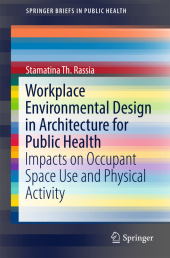 Neuerscheinungen 2017Stand: 2020-02-01 |
Schnellsuche
ISBN/Stichwort/Autor
|
Herderstraße 10
10625 Berlin
Tel.: 030 315 714 16
Fax 030 315 714 14
info@buchspektrum.de |

Stamatina Th. Rassia
Workplace Environmental Design in Architecture for Public Health
Impacts on Occupant Space Use and Physical Activity
1st ed. 2017. 2017. xviii, 94 S. 15 SW-Abb. 235 mm
Verlag/Jahr: SPRINGER, BERLIN; SPRINGER INTERNATIONAL PUBLISHING 2017
ISBN: 3-319-53443-2 (3319534432)
Neue ISBN: 978-3-319-53443-5 (9783319534435)
Preis und Lieferzeit: Bitte klicken
This concise volume analyzes the potential for the workplace environment-where so many people spend so much of their day-to improve workers´ capacity for health and wellness. It pinpoints the link between sedentary lifestyles and poor health, and explores the role of office spatial design in encouraging physical activity to promote physical activity, health and prevent disease. The featured research study tracks workers´ movement in a variety of office layouts, addressing possible ways movement-friendly design can co-exist with wireless communication, paperless offices, and new corporate concepts of productivity. From these findings, the author´s conclusions extend public health concepts to recognize that influencing population-wide levels of activity through office architectural design alone may be possible.
This SpringerBrief is comprised of chapters on :
Physical activity and disease: Theory and practice
Space-use and the history of the office building
Identifying factors of the office architectural design that influence movement,
Interdisciplinary research methods in studying worker physical activity, decision-making and office design characteristics
The KINESIS model for simulating physical activity in office environments
The questions and potential for solutions in Workplace Environmental Design in Architecture for Public Health will interest and inform researchers in interdisciplinary topics of public health and architecture as well as graduate and post-graduate students, architects, economists, managers, businesses as well as health-conscious readers.
Preface
Contents
Glossary
List of Symbols
Introduction: Office environmental design and public health: The challenge
A.1 Aims
PART ONE Physical Activity and Disease: Theory and Practice
Chapter 1 Physical Activity and Health Promotion
1.1 Physical activity and public health recommendation
1.2 Interdisciplinary approach to physical activity
PART TWO Space-use and the History of the Office Building
Chapter 2 Office Building: A Brief Historical Overview
2.1 Ancient times
2.2 Modern era
2.3 From the 18th to the 20th century
2.4 From the 20th century office site to the new workplace
2.5 Current thinking and future design implications
Chapter 3 Current Office Design, User Activity, and Occupancy Evaluation
3.1 IT integration in space: Impacts on activity and job interaction
3.2 Effects of the design of offices on occupant activity and occupancy evaluation method
PART THREE Research Methods
Chapter 4 Introduction to Methods for Measuring Activity
4.1 The difference between space-use topography and topology
4.2 Physical activity measurement methods: Accuracy and cost
Chapter 5 Selected Research Methods of Data Collection
5.1 Method
5.1.1 Direct observation
5.1.2 Interview questionnaire
5.1.3 Diaries and activity monitoring
Chapter 6 Research Data Collection
6.1 Setting up the data collection
Chapter 7 Data collection results
PART FOUR Identifying Influential Office Architectural Design Factors of Mobility
Chapter 8 Statistical Analysis
8.1 Models
8.2 Participant characteristics
8.3 Observation clustering
8.4 Testing the research hypothesis
8.5 Results and discussion
8.5.1 Model 1. Results
8.5.2 Model 2. Results
Chapter 9 KINESIS model
9.1 The model
9.1.1 Justification of terms in the equation for U
9.1.2 Method to calculate E for a given trip
9.2 Simulation
9.2.1 A standard layout
9.2.2 Modified layouts
Chapter 10 Discussion
10.1 Architecture, occupant activity, and the management of office space
10.2 Challenges
Conclusion
Acknowledgments
References
Electronic sources


